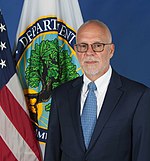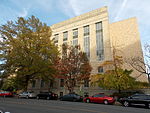Mandarin Oriental, Washington, D.C.

Mandarin Oriental Washington, D.C. is a luxury Postmodernist-style hotel located at 1330 Maryland Ave SW, Washington, D.C., in the United States. Since its opening, the Mandarin Oriental Washington, D.C., has been AAA-rated four diamonds and Forbes Travel Guide rated four stars. Completed in 2004, the hotel is near the National Mall and Smithsonian Institution museums, and overlooks the Tidal Basin. The Washington Post calls the hotels location "unconventional". The 373-room hotel is located near downtown Washington, although to reach Capitol Hill guests would need a taxicab or automobile. Guests in rooms on the upper levels have views of the city and its monuments, but the surrounding neighborhood consisted primarily of railroad tracks, freeways, and office buildings.The Mandarin Oriental features a curving Mansard roof punctuated a points by windows which are either round or arched, and often protected by a pediment. The facade is light tan brick, with double-hung windows in a repetitive pattern piercing the facade. Brennan Beer Gorman Monk also oversaw the interior design. The hotel's vast lobby is lined with marble, and public hallways feature rocking chairs and sofas.The hotel was built atop the CSX Transportation's RF&P Subdivision railroad tracks, which restored a segment of Maryland Avenue SW. An abandoned railroad bridge to the west of the hotel was converted into a pedestrian bridge and pathway, which connects the Mandarin Oriental and The Portals to the Tidal Basin waterfront.
Excerpt from the Wikipedia article Mandarin Oriental, Washington, D.C. (License: CC BY-SA 3.0, Authors, Images).Mandarin Oriental, Washington, D.C.
Maine Avenue Southwest, Washington
Geographical coordinates (GPS) Address Nearby Places Show on map
Geographical coordinates (GPS)
| Latitude | Longitude |
|---|---|
| N 38.883621 ° | E -77.030367 ° |
Address
Mandarin Oriental
Maine Avenue Southwest
20228 Washington
District of Columbia, United States
Open on Google Maps









